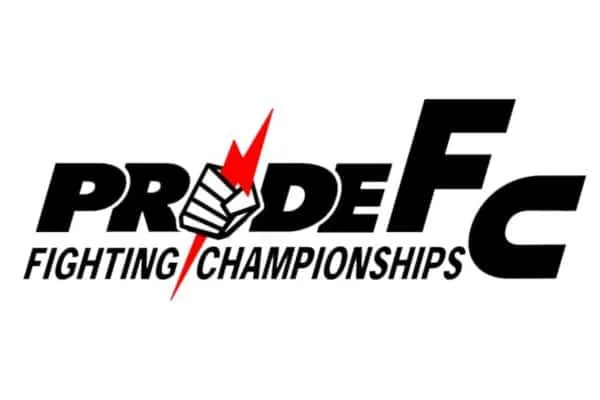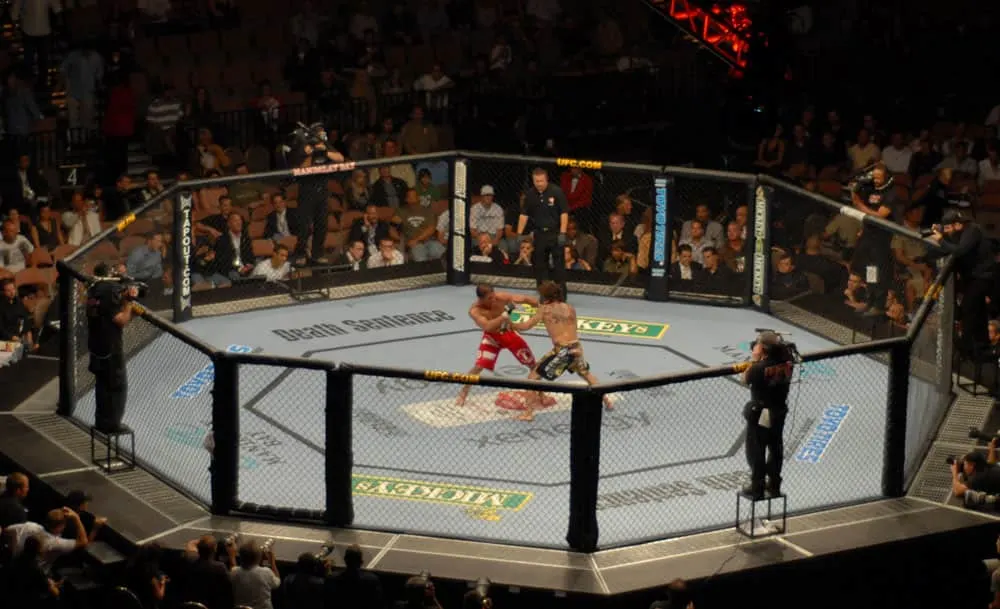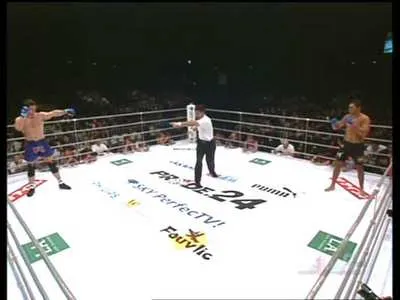
MMA fans, notably the new ones, can often hear stories about the glory days of Pride Fighting Championships(Pride FC or Pride) and how good it was back in the 2000s. People telling these stories tend to go even further by saying that Pride FC was the best MMA product ever. Even better than the UFC. But was it like that? And even if it was, how could such a big company collapse out of nowhere?
Pride FC was the most famous Japanese MMA promotion that was active from 1997 to 2007. From 2000, it was the home of the best fighters in the world, including the ones from the US, and its events were gigantic. It was a much bigger promotion than any other of that time, and being a Pride champ meant you are the best in the world.
But the Pride FC as a company collapsed quickly mainly due to their sudden loss of major TV deals with the Fuji network.
Still, this is just the tip of the iceberg and a brief explanation. Stay with us to find out more about what happened to PRIDE FC, what was unique about it, and how different it was from the UFC.
How Did PRIDE FC Go Out of Business?
Pride FC was one of those companies that went from top to bottom in a very short time span, and the exact cause of its fall is still unknown. It all started when the company lost its biggest TV deal with “Fuji TV” in 2006 which had a huge impact on their revenue. At the time, their main incomes were through various TV deals, and “Fuji” was the main one. The impact was so bad that Pride got out of business in less than a year, and it all ended with UFC buying Pride in 2007.
The main question is: why Fuji TV decided to get out of business with the most successful MMA Company?
According to many sources, this has a lot to do with the internal issues within Pride FC, people who ran it, or better to say “controlled” it. Around 2005, rumors were flying that Pride was under the control of the Japanese mafia group called “Yakuza”. This group used Pride to fix matches, manipulate the taxes, gamble, and do other illegal stuff. And like that wasn’t bad enough, many sources suggest that there was an internal war between two Yakuza groups over their interests in the promotion.
All of this had a huge impact on Pride FC as a brand and what it stood for, notably when it comes to its fans in Japan. You see, Japanese people were appalled by groups like Yakuza, or anything this group was involved in at the time. So when it became clear that they were involved in Pride, the image and TV ratings have plummeted.
It’s a shame that all the reasons behind its fall do not have anything to do with the sport and production itself. Pride events will forever be once in a lifetime spectacles.
Who owned PRIDE FC and where are they now?
The original founder of Pride FC was Nobuyuki Sakakibara who remained the owner until the very end. Before getting into MMA, he had a lot of experience in organizing combat sports events. He worked with various TV networks and was a part of the K-1 production. In 1997 and while being a member of the “KRS” promotion, he decided to start his own MMA show.
He organized the first three events under the name of “KRS-MMA”, with the help of his friends and colleagues. Following the fourth event, he formed a company “Dream Stage Entertainment Inc”, and build his own brand called “Pride Fighting Championship”.
Sakakibara remained the owner of Pride until the very end in 2007 when he sold it to the UFC’s parent company, Zuffa. But, he would stay in the fighting business and start a new promotion called “Dream” in 2008. Dream had some success in the beginning, but, it also collapsed in 2012.
Sakakibara decided to give it another go by starting another promotion, “Rizin FF” in 2015. As of 2021, Rizin events have been among the most popular in the eastern world and doing reasonably well.
Was PRIDE FC better than UFC?
Even in modern days, a lot of fans think that Pride FC was much better than the UFC. Yes, it all ended up with UFC buying out Pride in 2007, which shows us that the UFC ended up as a better business in the long run. But, during the early 2000s, it’s fair to say that Pride FC was, by far, the most popular MMA promotion. And it was bigger than the UFC if you look at the overall picture.
During the early 2000s, the UFC was going through a lot of changes. In 2000, the famous Fertitta brothers and Dana White bought the UFC for $2 million, and they focused on regulating the sport. We saw the birth of “Unified Rules of MMA” that changed the sport for the better, new pay-per-view deals, and many other changes. At the time, their goal was to build a strong base and strategy that would allow them to rise in the following years.
At the same time, Pride FC was rising at a rapid rate and was much popular than the UFC. It was the home of the best fighters in the world and the toughest competition. In fact, many UFC fighters moved over to fight in Pride during the early 2000s, out of which some were UFC legends like Don Frye, Mark Coleman (in 1999) and Royce Gracie.
Its events were gigantic like “Shockwave Dynamite” held in 2002 that holds a record for the largest live MMA audience ever (91,107 people). The magnitude of their events and TV deals they had was something the UFC could only dream about at the time.
Who were the Biggest PRIDE FC stars?
For almost a decade, Pride FC was the home of the best fighters in the world. When you look at its roster of fighters in each weight class, you can only see true legends of the sport. We would have to devote an entire article to make a fair list of the best fighters. But for now, here is a brief look at the biggest Pride FC stars:
Fedor was the greatest champion in Pride FC history, and among the best fighters to ever fight in MMA. During his days in Pride, Fedor was able to win the heavyweight title, defend it three times, and win the 2004 Grand Prix tournament. He left the company in 2006 with a record of 14–0 and on a 22 fight winning streak.
2. Mirko CroCop
CroCop was the 2006 Pride Grand Prix champion, and for sure, the best kickboxer we have ever seen compete in MMA. He was the most feared striker of the Pride era who knocked out many great fighters utilizing the famous left high kick. Here are some of his amazing records:
- Tied with Wanderlei Silva for most finishes (16)
- Most first-round finishes (15)
- Most wins though kicks (8)
Henderson is a true legend of Pride and the only fighter who was able to win titles in two separate weight classes. He won both the welterweight title and Grand Prix by beating Murilo Bustamante in 2005. Then, he moved up in weight to knock out Wanderlei Silva to win the middleweight crown in 2007.
Silva is a former Pride middleweight champion and 2003 Grand Prix winner. In the minds of many fans, he is the most violent fighter we have ever seen. He left nothing but carnage in each fight he stepped in, regardless of the outcome. He holds many records for:
- Most title defenses (4)
- Most wins in Pride history (22)
- Tied with Mirko CroCop for most finishes (16)
- Most knockouts in Pride history (15)
What was the Difference Between UFC and PRIDE FC?
Both UFC and Pride FC are two companies that, apart from promoting the same sport, do not have much else in common. If we set them against one another, these two differ a lot when it comes to rules, event format, and many other things. Here is all you need to know about the differences between UFC and PRIDE:
History— Founded in 1993 in the US, the UFC is the pioneer of modern MMA in the western world. Pride FC, on the other side, emerged a few years later in 1997 in Japan. Its precursors were some other Japanese MMA promotions like “Shooto” and “Pancrase”. Yet, these two focused more on shoot style wrestling, while PRIDE was the first one to promote pure MMA matches.
Rules — The UFC played a big role in creating the “Unified Rules of MMA” which they adopted in 2000. Pride FC never adopted this set of rules since they had their own rules that were much different in many areas. Keep reading this article as we will explain all the differences in rules later in this article.
Weight classes — Nowadays, UFC has 12 weight classes in total out of which eight are for men and four are for women. But in the early 2000s, the promotion didn’t include women’s MMA, which they have started promoting from 2012. Pride also didn’t have weight classes for women during its existence. They only had five weight classes for men, out of which one was “open weight”.
Event format — Pride FC had champions in each weight class. Still, their “Grand Prix” tournaments were the most popular MMA events in the world at the time. We saw the best fighters competing multiple times in a single night, which was crazy to watch. UFC also had tournaments in the early 90s, but they abandoned that concept after just a couple of years.
Fighting Area— UFC uses the octagon-shaped steel cage. In present days, there are larger and smaller versions of the octagon. But the original one is 30 feet in diameter, 6 feet high, and has 750 square foot fighting area. Pride FC used a five-roped square ring, with each side of the ring being 23 feet long (7 m).

Photo by Lee Brimelow

UFC vs PRIDE FC Rules— What was the Difference?
The rules between these two promotions differed a lot because the UFC adopted the Unified Rules, while Pride didn’t. The Japanese promotion had its own rules that were much different in just about every aspect. Here is all you need to know:
Rounds
The UFC nontitle bouts include 3 rounds while the title fights are 5 rounds. Each round is 5 minutes long with 1-minute rest between. In total, most UFC fights include 15 minutes of action, while the ones for the title are 25 minutes.
Pride FC matches also included 3 rounds, but, the first round was 10 minutes long while the second and third were 5 minutes. And the rest period between the rounds was 2 minutes. In total, the matches were 20 minutes long. The only exception was during the Grand Prix (GP) events. If two rounds of GP took place on the same night, then each bout consisted of two rounds with the first one being 10 minutes and the second five minutes long.
Illegal strikes
Pride FC rules included many strikes that were and still are illegal in the UFC. For instance, the notorious soccer kicks to the face, foot stomps, and knees to the grounded opponent. These strikes are all illegal according to the Unified Rules. But, some strikes that UFC allows, like elbows to the face, were illegal in Pride.
Gloves
Both UFC and Pride used open finger gloves that are around 4–6 OZ in size. Although the size was the same, the design of the gloves was much different. The popular opinion is that Pride had a better design since the glove caused the fingers to curl back when in a neutral position. This stopped fighters from fully extending their fingers and we had a much lower rate of eye pokes as a result.
Scoring system
The UFC uses the famous “ten-point” scoring system adopted from boxing where judges score the fight round by round. They use the following criteria to decide the winner of the round (in this order):
- Effective grappling or striking
- Effective aggressiveness
- Fighting area control
Pride FC had a different scoring system where judges scored the fight in its entirety and matches couldn’t end in a draw. They used the following criteria to decide the winner of the match (in this order)
- The effort made to finish the match
- Damage given to the opponent
- Standing combinations or ground control
- Takedowns and takedown defense
- Aggressiveness
- Weight (if there is a difference in weight between the fighters)
Drug testing
UFC fighters must adhere to State Athletic Commissions’ rules to avoid using medication that may enhance performance.
Pride FC was not regulated by Athletic Commission since it was not a U.S.-based promotion. Pride FC never tested its athletes for performance-enhancing drugs in its existence (1997–2007).
Related Questions
Who bought Pride Fighting Championship?
In 2007, the UFC’s parent company called “Zuffa LLC” bought Pride FC after 11 months of intense negotiations. The two sides closed the deal on May 25, 2007, with UFC paying less than $70 million to buy all Pride assets from Dream Stage.
Was Pride FC Fighting fake?
Pride FC was a real MMA promotion that wasn’t fake at all. In fact, it was way more brutal than modern UFC as it included notorious strikes like soccer kicks, stomps to the face, and knees to the grounded opponent. Back in the early 2000s, it was the most popular MMA promotion and home of the most skilled MMA fighters. Many Pride FC fighters would later join the UFC and become champions.
